

Click on the thumbnail images below to view larger images of the weavings. Links in text show details of the designs.
Pictorial rugs
Prominent during the last half of the 19th century, pictorial rugs reflected the new and changing world of the Navajo. The establishment of Trading Posts in the 1870s and the coming of the railroads to the Southwest region brought new ideas and materials to Navajo weavers. Weavers incorporated various cultural influences into beautiful weavings that mirrored life on the newly resettled reservation. Pictorial rugs contained whimsical animals, birds, and figures, used as both filler elements and major design features. Although we do not know the specific history of many of these pictorial textiles, all demonstrate the artistic ability and adaptability of Navajo weavers.
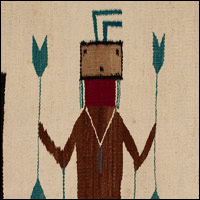
This Yei rug was in Joe Ben Wheat's personal collection before it came to the Museum. The front-facing figures are Yei, Navajo deities or Holy People. Weavings with Yei figures are not sacred, nor are they used in rituals, but they do feature imagery from sandpaintings, more accurately called drypaintings, created for ceremonies. When Yei figures were first used as subject matter in rugs around the turn of the century, there was strong opposition from many Navajos, including weavers. Some contemporary weavers still express concern about using this imagery in their weavings.

Navajo Yeibichai are masked human dancers impersonating the Yei deities of Navajo cosmology. In the earliest pictorials, Yeibichai were shown in frontal view, but by 1925-1930, most Yeibichai pictorials show the dancers in profile. The Yeibichai are often featured in a ceremony called the Nightway Chant dance. The traditional blue case mask worn by the dancers is seen in several of the Yeibichai pictorial rugs in this exhibition.
Talking God, who is often dressed in white with full feather headdress, usually leads the long line of Yeibichai dancers. Of course, since the weaver was free to express her ideas artistically, a wide variety of Yeibichai textiles were created that do not represent any specific dance or ceremony. The variety of Yei and Yeibichai pictorials in this exhibition illustrate each individual weaver's interpretation of the Navajo Holy People. These textiles are never used in religious ceremonies, nor do they function as prayer rugs. This type of rug is still woven in all parts of the reservation, but certain areas were strong weaving centers of Yei designs, such as Shiprock, Ganado and Lukachukai.
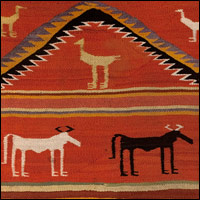

Human figures in early rugs came in diverse shapes and sizes and often floated in space or stood in rows. The minimal male figure with a wide-brimmed hat seen here suggests a rancher or cowboy. The female figures appear to be holding hand-cards, used for carding wool, thus the textile could be depicting the weaver and her husband. Weaving tools were often woven into textiles as design elements.
The border in this textile is typical of the time period, as traders encouraged weavers to add borders, unknown in the earlier striped classic-period textiles. Mexican serapes imported from the Saltillo area of Northern Mexico had a strong influence on Navajo weaving. Diamond designs were used both as major elements or to fill in backgrounds. Letters were often used as graphic devices in early pictorial weavings and can be seen in this piece simply as shapes and design motifs that pleased the weaver. Bows and arrows were popular motifs as well and the star may have been borrowed from the Texaco Oil Company logo that was well known in the Southwest area at this time. This textile is an excellent example of how Navajo weavers combined multiple elements into pleasing designs that emerged from their creative imagination yet still reflected their cultural landscape.
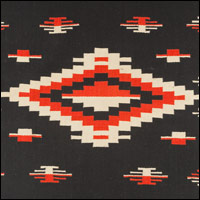
Whirling Logs is not a swastika.
The whirling logs symbol appears in many Yei, Yeibichai and other pictorial weavings. It is a symbol used by the Navajo for centuries, primarily in sandpaintings and may represent the four cardinal directions. Weavers used it in their designs because of its strong graphic qualities. During the late 19th century through World War II, traders encouraged weavers to use Navajo ceremonial symbols in their work to increase the sales to tourists and collectors. It did not have any connection to the swastika symbol later appropriated by the Nazis.
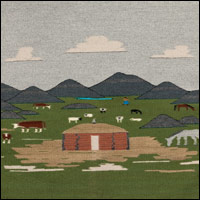
In the center of the pastoral scene sits the hogan, tradition home of the Navajo people. The door faces east in this six-sided dwelling, looking toward the rising sun and the coming of a new day. Early hogans were constructed almost entirely of logs, sometimes covered by red dirt. A central fire provided cooking and heating. Today's Hogans are constructed of wood and contain many modern conveniences, but the door still faces east. This pictorial probably encompasses the weaver's world, with her hogan at the center, surrounded by her animals and the mountains.

Storm Pattern Stories
This popular style has a number of stories attached to the development of the design and the interpretation of the layout and various motifs. Some speculate that the design came from flour sacks, while others believe early traders attached stories of Navajo symbolism to the design as schemes to sell more rugs. JB Moore, who ran the Crystal Trading Post, did have a similar design in one of his catalogues published in the early 1900s and he intrigued buyers with tales of Navajo mythology. Scholars have found no evidence of this design in sandpaintings or early weavings, but the influence of Oriental rug designs published by Moore may have inspired weavers.
Storm pattern design elements are interpreted in many ways. Common explanations describe the center box as the center of the world, a hogan or lake. The four corner boxes are variously known as the four sacred mountains of the Navajo or the four houses of the wind. The zigzag lines extending from the center to the corners are usually described as lighting lines or the whirling logs seen in sandpaintings. The small figures between the lines are referred to as water bugs or piñon beetles and they resemble motifs on Oriental rugs. Some contemporary weavers may believe the elements in the textiles are symbolic, while others enjoy creating this eye-catching style because it challenges their weaving skills.

Compare this storm pattern pictorial with a more traditional storm pattern textile. In addition to the strong lines stretching out to the corners, this piece has red birds contained in a central star rather than a square. Birds are used in many pictorial designs. The color of the birds may have significance to the Navajo weaver or may be chosen simply to create a pleasing design element.
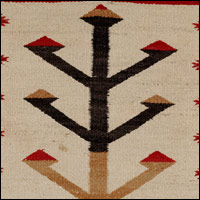
The Navajo consider corn, beans, squash and tobacco to be sacred plants. This may be a very simplified version of a sacred corn plant. In many weavings, corn plants are presented as "corn Yei" with birds on branches and various symbols included in the design. In this example, only the sturdy corn plant is emphasized, highlighted with a border of serrated diamonds. This piece is probably a Gallup throw. Large numbers of these standard size textiles, 35 x 18 inches, were made and distributed around Gallup, New Mexico. These popular small pieces used cotton warps and handspun weft as in this example.
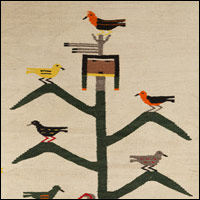
This weaving features the corn Yei with birds nesting in the branches. The three roots at the bottom of the corn plant hint at emergence from the third underworld in Navajo cosmology. Birds are often viewed as sacred messengers, bringing messages from the Holy People to the Navajo.